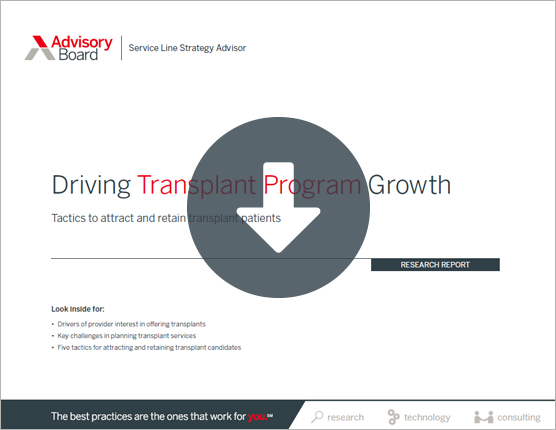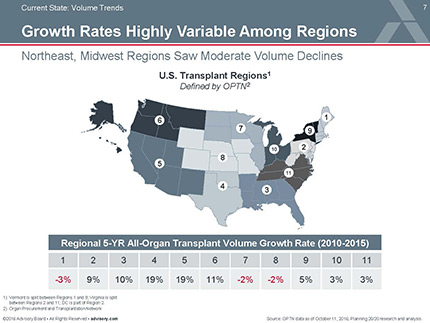Auto logout in seconds.
Continue LogoutThirty-four years after Wayne Cooper, an obstetrician, delivered his daughter, she saved his life by donating more than half of her liver, Lenny Bernstein writes for the Washington Post.
Feb. 1 webconference: 2018 market trends for general surgery
According to Bernstein, the "living donor" donation made by Wayne's daughter, a 34-year-old attorney, is fairly rare in the United States. Of the 7,841 livers donated in the United States in 2016, just 345 were from living donors, according to the United Network for Organ Sharing (UNOS), which coordinates transplant lists.
The comparatively low number of living donor donations persists despite ongoing demand for livers, Bernstein writes. More than 14,000 people were on a waiting list for a liver throughout the country in 2016, and around 1,000 die every year because they don't receive one in time.
An innovative procedure—but also a risky one
According to Bernstein, living donor donation for livers is possible only because the liver is a regenerating organ. As a result, if a patient and donor are a match, patients can side-step a years' long waitlist by receiving a part of their donor's liver.
However, the living donor procedure exposes both patients to the risks of a major surgery—and that gives many health providers pause in agreeing to perform such surgeries, Bernstein writes. Rolf Barth, the director of liver transplantation at the University of Maryland School of Medicine, said, "This is one of the few transplants we do where you could have two people die instead of one person die."
But if both patients survive the procedure, the results are promising. For instance, in Maryland, where the Coopers had their transplant done, recipients of livingliver donations typically do as well as or slightly better than those who receive cadaver livers, according to Barth and John LaMattina, the director of the University of Maryland's living-donor liver transplantation program. And that trend applies nationwide, according to UNOS. Research has found that only a small number of donors have had complications.
The surgery
According to Bernstein, Patricia offered to serve as a living donor for her father, Wayne, after Wayne's health declined following his diagnosis with liver disease and his other health factors—including age, diabetes, and heart problems—made him unlikely to receive a liver donated from a cadaver. Wayne said he rejected the idea until Patricia pointed out that Wayne himself would have done anything to help his own father, who passed away from heart disease at 58. "She's a lawyer," Wayne said. "She's good with words. So she turned the tables on me."
Patricia added, "It wasn't even a choice. It's my dad. Of course I'm going to do this. I knew the mental anguish of him dying and me thinking I could have done something to save his life was going to be worse than any physical pain."
But even after Wayne agreed to the procedure, the father-daughter duo encountered additional obstacles: Wayne, at 70, was at the upper end of a limit many surgeons impose when considering transplant eligibility. In fact, the Coopers had been rejected from at least one transplant program, Bernstein writes, after providers said the case involved too many risks.
The surgery hit another roadblock because of concerns that Patricia's liver was too small to provide a large enough donation to her father while leaving her with enough of a liver to survive. However, after Wayne and his wife, Bonnie, discussed the living donation process more in depth with Barth and LaMattina at the University of Maryland, the surgery was scheduled.
Patricia donated the entire right lobe of her liver, which comprised about 59% of her liver volume. According to Bernstein, Wayne is currently resting and recuperating at home, taking immunosuppressants so his body won't reject his daughter's liver—and doctors expect that when Wayne does pass away, it won't be from liver disease. "We tell all our patients that's our goal—that they would die of old age in their sleep," LaMattina said.
And Patricia is also doing well, having recently returned to work. "When these (surgeries) go well, they are wonderful, wonderful things," LaMattina said. "This is a story about the donor. The donor is going through something they don't need, that's a big deal, that's a risk, to do something for someone they care about" (Bernstein, Washington Post, 1/6).
Feb. 1 webconference: Get the 2018 market trends for general surgery
Increasingly, general surgery leaders will be tasked with evolving their planning efforts, in response to minimally invasive technology innovations, payer pressures, and a continued shift toward outpatient care.
This webconference reviews these and other market trends impacting the general surgery service line and summarizes tactics necessary for growth in the upcoming year.
Don't miss out on the latest Advisory Board insights
Create your free account to access 1 resource, including the latest research and webinars.
Want access without creating an account?
You have 1 free members-only resource remaining this month.
1 free members-only resources remaining
1 free members-only resources remaining
You've reached your limit of free insights
Become a member to access all of Advisory Board's resources, events, and experts
Never miss out on the latest innovative health care content tailored to you.
Benefits include:
You've reached your limit of free insights
Become a member to access all of Advisory Board's resources, events, and experts
Never miss out on the latest innovative health care content tailored to you.
Benefits include:
This content is available through your Curated Research partnership with Advisory Board. Click on ‘view this resource’ to read the full piece
Email ask@advisory.com to learn more
Click on ‘Become a Member’ to learn about the benefits of a Full-Access partnership with Advisory Board
Never miss out on the latest innovative health care content tailored to you.
Benefits Include:
This is for members only. Learn more.
Click on ‘Become a Member’ to learn about the benefits of a Full-Access partnership with Advisory Board
Never miss out on the latest innovative health care content tailored to you.


